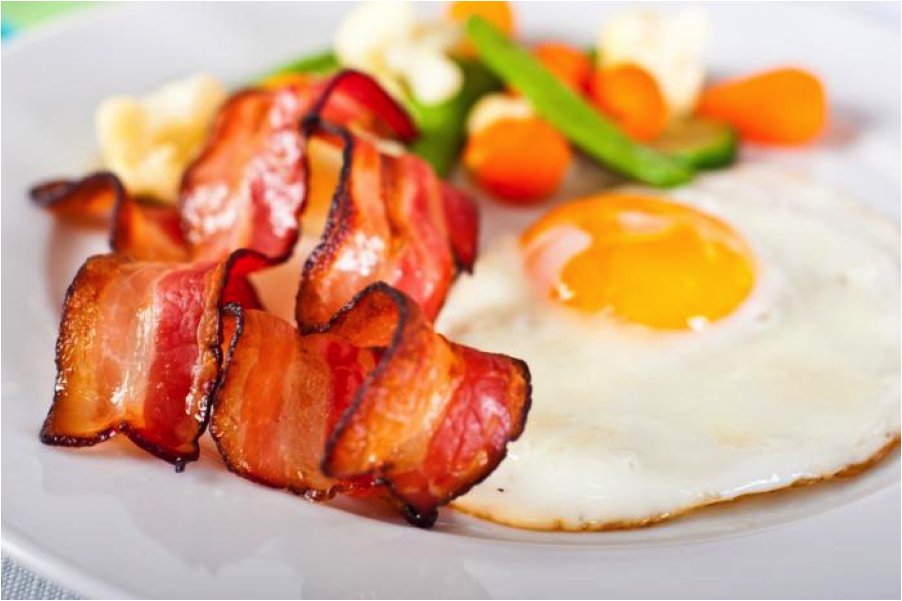
Having recently published a book wholly embracing dietary fat (especially animal fat) as literally being central to human health, the title of this article might seem a bit surprising. But I realize that there is still some confusion out there, and I feel the need to clarify a couple of points:
First off, it may shock you to hear that more fat is not always necessarily better.
Say WHAT???
Allow me to explain…
Although the sub-title of my new book mentions the words “High-Fat, Low-Carb Paleo Diet”, the intent was not to promote the consumption of extra dietary fat at every turn, or, encourage, say, drinking lard. I jest a bit, but I have stated many times that the dietary approach I advocate is not so much a “high-fat” approach as it is a “high percentage fat” approach. Unfortunately, adding the word percentage to the cover of the book would have added to an already quite wordy sub-title and that, well, wasn’t going to happen. So I was left to try to explain what that meant within the pages of the book. Hopefully I was able to clarify this reasonably well for those of you who have actually read my book. If not (or if you still feel unclear about this issue), read on…
When I say “high-fat” I am not talking about eating a brick of Kerry Gold butter at the end of a popsicle stick (as delightful as this may sound to some).
This, instead, is what I mean:
By eliminating sugary and starchy carbohydrates and moderating your protein intake, while eating a wide variety of fibrous vegetables and greens there is an automatic caloric vacuum created that needs to be filled if a person is to meet their energetic/caloric needs day-to-day.
I have submitted that dietary fats from a variety of unadulterated, 100% pastured and organic, nutrient dense and fat-soluble nutrient-rich sources should be the primary source of calories in any given meal. But by no means does this imply “the more fat the merrier”. Not at all.
And that’s where people get tripped up.
It’s understandable, in a way, but this really needs to be clarified. The right idea is eating “enough fat” in order to meet your energetic and fat-soluble nutrient/essential fatty acid needs… Which in most cases should be sufficient to also satisfy your appetite. Rich foods are inherently satiating, after all, and the idea is to mimic the health promoting and longevity effects of caloric restriction without feeling deprived. The idea is not, conversely, to indulge in a depraved and unbridled orgy of grease-gorging.
The recent exoneration of dietary fat–and especially dietary animal fat–within the peer-reviewed literature and within the psyche of increasingly more people has led to an unfortunate tendency to overdo things a bit. The popularity of ketogenic diets has similarly led to an explosion of ketosis-enhancing products that are getting used in all sorts of ways that I believe are highly questionable. It is typical of human nature to swing to extremes, or pull out the stops once they hear that a certain food might actually be good for you. If a little is good, many typically reason, more should be even better! “PLEASE PASS THE LARD!!!” Not necessarily so.
Nowadays you can’t swing a dead cat without hitting somebody drinking coffee laced with MCT oil and butter. Extra fat seems to pile or pool on every other plate… And worse yet, those who continue to embrace the idea of eating starchy and sugary (albeit “natural” and “Paleo-friendly”) carbohydrates want to have their proverbial cake and eat it too– topped with high-fat frosting, so to speak. These are mistakes… And they can be costly mistakes to your health and waistline.
SO–What is your dinner plate supposed to look like?
Ummmm…NOT this:
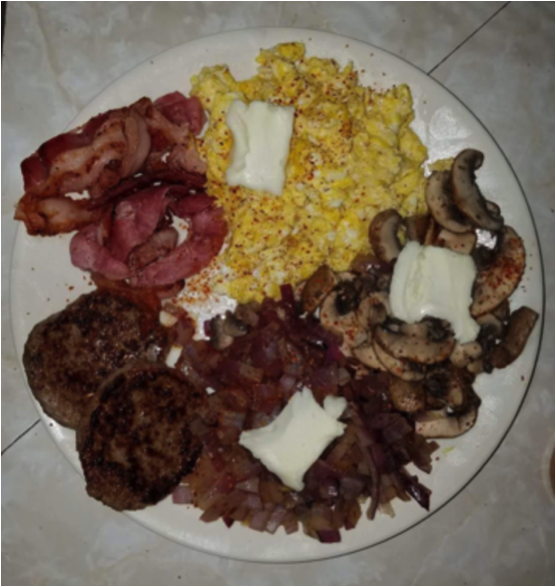
And DEFINITELY NOT this!
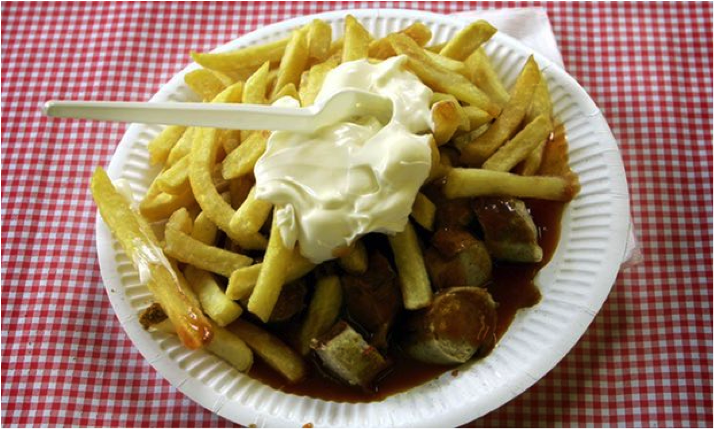
More like this (a ‘Primalrito’):
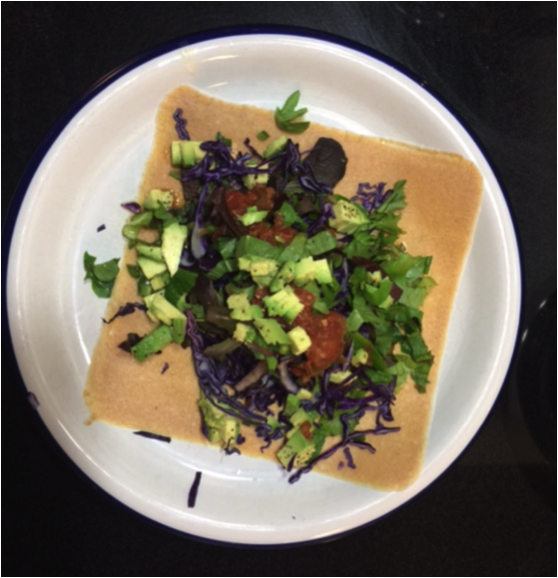
Or maybe this (Pork Breakfast Patty with Sautéed Greens/cultured vegetables):
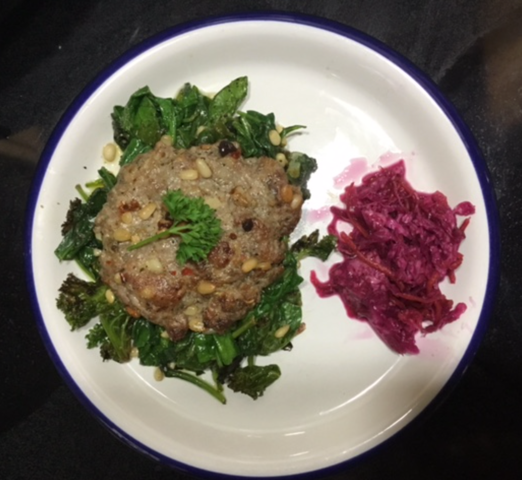
The bottom line really isn’t the calories. The whole caloric thing has been debunked many times over. But it’s not that calories don’t count at all. They certainly can. As I have pointed out multiple times before, a calorie isn’t a calorie isn’t a calorie. The human body is not a heat engine, but instead a complex biochemical factory. Food initially goes toward replenishing fundamental nutrient and structural needs prior to apportioning any remaining calories for the purposes of energy production or storage. Plainly put, different types of foods are going to be used differently by the body.
Dietary fat and protein first go to replenishing structure and repair. Fat is the second most abundant substance in your body aside from water. It makes up the bulk of the human brain and nervous system—by far the most fat-rich and metabolically expensive tissues in the body. Quality dietary fat goes to building/rebuilding every single cellular membrane in your body; it goes to supporting a wide variety of immune and endocrine processes, and more. Dietary protein, too, goes toward meeting a variety of structural needs: organs, tissues, muscle, neurotransmitters, enzymes, etc. Fortunately, we have developed an efficient means of recycling a lot of protein within the body (typically about half our daily needs can be met this way), and our leftover protein needs are relatively easily met by consuming no more than about 6 to 7 ounces per day of complete-source protein. But once that protein intake is actually exceeded, certain reproductive metabolic processes are triggered that have the potential to derail your weight loss efforts; and worse, compromise your health and longevity. If you are pregnant, trying to get pregnant, or are a growing baby, child or teen then some extra protein is absolutely necessary. It’s working hard to make new needed cells. We have a scientifically established human dietary requirement for certain fatty acids and fat-soluble nutrients; along with certain amino acids from protein.
BUT virtually every molecule of carbohydrate-based food (sugar and starch, that is) is typically considered “excess” by a body that has no fundamental, scientifically established dietary requirements for it. So your body produces insulin in response to consuming carbs as a means of rapidly getting it out of the bloodstream and injecting whatever glucose might be needed in the cells at the moment (which is rarely very much, except during an emergency), and then dealing with the rest of it by storing it however one can. Also, since carbohydrates are non-essential in the diet, ultimately every carb calorie definitely counts! Rather than being a blood sugar hormone, insulin’s job first and foremost is to take excess nutrients and move them in to storage for a rainy day (i.e., in case of a famine). The majority of anyone’s carb intake is automatically “excess”. That’s why it impacts insulin so strongly. Whatever can’t be stored as glycogen in the liver or in the muscles (and again, those storage sites fill up quickly) typically gets converted into triglycerides (blood fats) by the liver and then gets deposited in places we would mostly rather not have them.
Of the three major macronutrients: proteins, fats and carbohydrates, by far the ones we most need to keep under control (when it comes to eating for health and human longevity) are carbohydrates (in the form of sugar and starch), and protein. I have discussed the effects of the protein-sensing mTOR metabolic pathway and the longevity-compromising effects of eating too much protein in all of my books. In a manner of speaking, however, fat is technically a “free fuel” in this relative regard. It has not been demonstrated to contribute to deleterious metabolic or aging processes. If you are metabolically adapted to using fat as a primary source of fuel then you are likely experiencing most of the health and longevity benefits associated with caloric restriction. But this doesn’t mean that fat-indulgence is therefore a “free-for-all”. If you eat fat well over and above what you really need to meet your structural, neurological, immunologic, cellular and other needs, then you will quite likely store those excesses as well. And if you combine carbs and fat together (heaven forbid), you are in effect sticking a lit fuse on top of a nasty powder keg metabolically. The insulin you generate in response the carbs combined with fat will shuttle away both to your thighs and love handles. It is not a fabulous combination.
If you are trying or struggling to lose weight, this becomes all the more important.
As I have said many, many times, dietary fat means ‘survival’ to our primitive human physiology. If you don’t eat enough fat, then your body will simply get better at making more of it from other things (mainly carbohydrates), and your body becomes better at hanging on to the fat stores you already have. So eating enough fat to send the message to your hypothalamus that “hey, relax…hunting is good” allows for the free release of body fat stores to more freely burn as fuel. This is a good thing and is what we want.
But consider this: if you are adding a lot of extra fat to everything all the time– even if you are technically operating with a fat-burning metabolism, you will have to burn through at least some of that dietary fat before you get to burning your own body fat. That’s the rub.
This is also a potential issue with ketone-enhancing supplements, which include both racemic/synthetic and ketone salts and things like MCT oil. A little of this can help kick start/catalyze a fat-burning metabolism and help someone more easily transition from sugar burning to fat burning. A little of this can enhance performance for certain demanding/athletic events. –All fine and good, more or less. But regularly taking exogenous synthetic ketones and chugging MCT oil past a certain point is simply pouring in more outside fuel for you to burn before you even get a chance to start burning your own internal fat stores. In other words, it’s anything but a fast track to sliding effortlessly into your skinny jeans.
The trick lies in adopting a fat intake that is high enough to meet your nutrient, hypothalamic and metabolic needs without flooding yourself with a bunch extra that forces your own body fat to get in line when it comes to getting burned for fuel. Frankly, it’s an all-too-easy mistake to make. I would say that eating too much protein is probably the single most common mistake I see people make when adopting this way of eating. If in doubt, lower the amount of protein you are eating and increase the fat a little (olive oil, macadamia nut oil and coconut oil are going to be the easier fats to burn in the beginning). Later on, the type of fat matters less when it comes to fully operating on an efficient fat-burning metabolism. But also be mindful of how loosy-goosy you are getting with the dietary fat, too.
My 21-day meal plan and recipes in Primal Fat Burner do a pretty good job of supplying just the right amount of everything so that you can get feel for how this works. Once you get it, it’ll be like riding a bicycle. –A very tasty, healthy, easy to ride and satisfying bicycle!
It is very easy to get caught up in all of the enthusiasm surrounding the exoneration dietary animal fat, and fat in general—Not to mention the exploding popularity and wide range of well-researched benefits associated with a fat-based, ketogenic way of eating. It is the now-popular bandwagon that comes most naturally to the human body and definitely satisfies our most primitive taste buds and bodily requirements. But quality counts (first and foremost), and a certain amount of restraint also counts when it comes to your total fat intake (unless you live or work in a cold environment or have an especially physically demanding job). If you are mindful while you eat and allow yourself to take in the aroma of the food and notice the feeling/texture and rich flavor while chewing and savoring every bite, then chances are you will naturally reach the right satiety and it will come automatically to you. If, on the other hand you have a tendency to wolf your food down and not pay attention while you eat, then it is way easier to overdo it and sabotage your own progress. Don’t be surprised if you find yourself frustrated with your weight loss efforts.
A little mindfulness goes a long way to making all this easier and restoring your rightful relationship with your own body.
Nothing could be more natural.
~ Nora Gedgaudas, CNS, NTP, BCHN
Check out my internationally popular Primal Restoration® Certification Program. More info here.

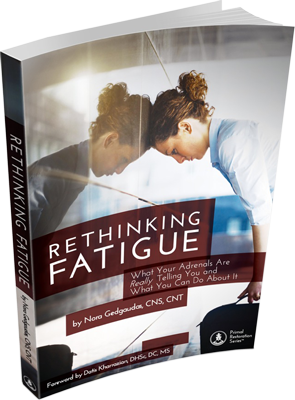
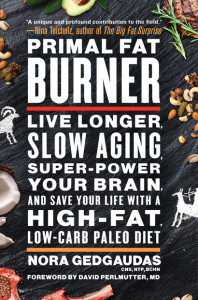

Hi Nora
I’ve read elsewhere that eating cold rice or potatos (after being cooked) is a good thing as it is a form of resistant starch that doesn’t get absorbed by your intestines? Your comments would be helpful.
Your new book is very informative and is shedding some light on where I’m going wrong on my diet. I’ve recently added 10 pounds to my waiste line over the past year. It seems I’ve strayed off the paleo path!
Best regards
John
I got your Primal Fat Burner book from Audible. I found it very interesting and appreciated all of the arguments for a Low Carb diet. However, it is not very useful to have the lists and recipes in audible form. Could you provide a pdf with these? Thanks
Thxs. Most of all for your continued work
This is a great article. It is overwhelming for sure to know what is the right amount. Should we avoid adding fat to coffees, shakes, etc? Just get fat from the foods that already have fat in it?
I add MCT in my kids shakes and MCT in my coffee with butter.
Thank you
Best,
A lot depends on what you are trying to accomplish. If you are trying to lose weight and can’t, you might try refraining from the extra fat added to foods and beverages. If weight is not a concern for you, then the amount of fat you are consuming really isn’t, either. This mainly has to do with those struggling to lose weight.
As much as I love butter, I tried to discourage people from using it mainly because it has such a powerfully antigenic potential in so many more people than are likely to realize it. If you have had Cyrex Labs testing and have received verification of having no immune reactivity to dairy proteins, then have at it. Otherwise, there could be the potential for triggering gluten-cross-reactive and other inflammatory processes that may be getting in the way of your best health efforts. If you really like that buttery flavor in your coffee, then you might consider the specific Cultured Ghee made by Pure Indian Foods, which has been lab tested to show non-detectable levels of dairy proteins in it. It’s extremely lovely and extremely rich in all the good stuff you would find in grass fed butter, if not more. If you are in the process of trying to adapt to a ketogenic state or feel like you need a little extra ketogenic boost first thing in the morning, then the MCT Oil is okay. Just don’t overdo it. Remember, anytime you are adding stuff like this you are adding extra fuel that you may or may not need. Again, a lot depends on you, whether you are experiencing any insulin resistance or not and your other health goals.
Dear John,
There is nothing about cold cooked rice or potatoes that is remotely “resistant” when it comes to starch. They are both profoundly starchy and insulin-provoking if they have been cooked. Even if they are cold. Resistant starch commonly marketed as such comes from raw, uncooked potato flour, raw plantains, so-called “Tiger nuts” and other raw, starchy tubers. I see this as mostly a fad, and completely unnecessary if you are consuming sufficient fibrous vegetables and greens. So-called “resistant” starch is called what it is because it takes prolonged heating to make the starch in any given food bioavailable to us humans. The process of prolonged heating of starch in a way that makes it edible is known as “gelatinization”. Starchy roots and tubers in their raw form are indigestible to us, or rather “resistant to digestion”. Hence the term, “resistant starch”. The concept behind using them is that even though we can’t digest or make use of them, technically the bacteria in our guts can. Therefore, they are being marketed as something that feeds the health of your gut microbiome (unless of course you happen to have SIBO or dysbiosis). This is frankly overkill if you are eating any reasonable amount of fibrous vegetables and greens, as already mentioned.
There are those that insist on promoting white rice and potatoes as some form of “safe starch”, which in my experience is anything but either. These foods will readily kick you out of ketosis and add to your metabolic challenges. There is no scientifically established human dietary requirement for any form of carbohydrate, and of all of the hormones that have the potential to help your body burn fat, there is one that will stop it every time: Insulin. The one macronutrient that is most likely to stimulate an insulin response in your body is carbohydrate in the form of sugar or starch. There are other things that have the potential to trigger in insulin response–not the least of which includes inflammatory processes, but avoiding the consumption of sugary and starchy carbohydrates is one trigger that we all have control over. If you are trying to lose weight then losing the carbs is your best first step. I hope this helps!
Hi Carol, My publisher has just told me that Audible has agreed to provide (1) A complete new audio file with the recipes (2) A PDF of the recipes. They are suppose to contact you but in case they don’t please contact them for those files. Thanks!
Hi, Nora- thanks much for this article- you make abundant sense here. Yes, it’s easy to go overboard with the fats, since the main idea we keep hearing about this way of eating is that when dietary carbohydrates are kept very low, we need not fear fat any more, and we can eat all the fat that we want and we won’t store it in the body.
I’m 63, 5’8″ tall, and currently about 160 lbs- 10 weeks into eating the ketogenic way. I was about 175 lbs to start with.
Lately, I have been more mindful of my eating, as you suggest, and I find that I am eating somewhat less than I was previously. I often make a two-egg cheese omelet with a few bacon strips for breakfast, and I would typically eat it all. I find now that sometimes I don’t feel like eating all of it at one sitting- so I’ll save the leftovers to add to my next meal. I try to eat until I’m no longer hungry, and not more than that.
And, a few times, I have done a bit of “intermittent fasting”, delaying my first meal of the day by a few hours and letting myself empty out a bit. This actually feels good, and then I’m ready to eat a meal and enjoy it more. That’s one thing that I’ve noticed- I can fast for part of the day and I don’t really get hungry- not in the same way that I did when I was a sugar-burner. I don’t get hunger pangs any more. Now, it’s more like a gradual “emptying-out” feeling- not uncomfortable. I think I could do a 24-hour fast with no problem.
I think my fat loss is continuing, but slowing, as I near my “maintenance weight”, which I’m guessing will be somewhere around 150 lbs (~140 lbs lean body mass). This makes sense- if I understand correctly, as we near our body composition goal, we need to bring the dietary caloric intake down a bit so that we continue to have a daily calorie deficit and burn off bodyfat stores. One great thing about being in ketosis and having plenty of fats in our diet is that satiety is high, even with a calorie deficit.
I find that when I eat a rich meal, the energy effect lasts for many hours. Often times, that 1 rich meal is the only meal I will eat in a day. Or, if I eat again, it is very little.
My rule of thumb is to listen to your body. It will tell you if it is hungry.
I eat a large salad with lots of olive oil, along with 3 oz of meat with a tbl spoon of”good” fat, or more olive oil on it along with 2 tbl spoons of coconut oil and MCT mix for lunch. My next meal is the same without the coconut oil. Is this too much fat? I am 75yrs, ideal weight and good health.
My ketons are very good but my fasting blood sugar is 103-107.
I love your books and follow you regularly.
I am so happy to hear about the PDF you are providing with the audible version, I could listen to the recipes but did not have the PDF available, I will contact them. Thank you!!!
Do You know at dr Kwasniewski form Poland wrote about the diet of a high-fat and bad role of carbohydrates in the diet about 30 years ego. . he had great difficulties and problems with doctors. It was difficult for him to enter it. Now few people question it.